Shalom (again) from Tel Aviv!
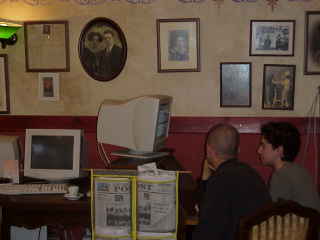 Hi again--this is page two, or, more technically, day two, of our stay
in Tel Aviv, but we're updating it from Jerusalem.
Hi again--this is page two, or, more technically, day two, of our stay
in Tel Aviv, but we're updating it from Jerusalem.
Before I forget, here are the pictures of the people who helped me out
at the InBar cafe in Tel Aviv (I sorta promised them the pix would be
included in my last download). Their names are Hadas and Eran (Hadas is
the woman), and they were really cool. Eran was fascinated by my camera,
so I took the following picture of him and Hadas.
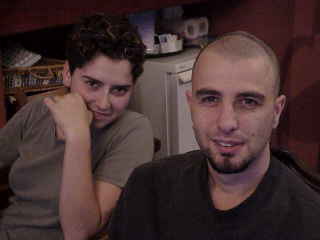
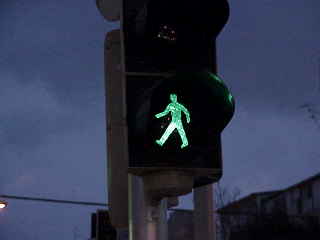 Another thing I didn't want to forget to mention, that Adam and I
thought was funny, was the walk signs in Tel Aviv.
Another thing I didn't want to forget to mention, that Adam and I
thought was funny, was the walk signs in Tel Aviv.
Unless I'm mistaken, they are walking in the opposite direction of the little green men in American walk signs.
Perhaps because they read right to left, they see
themselves walking that way too?
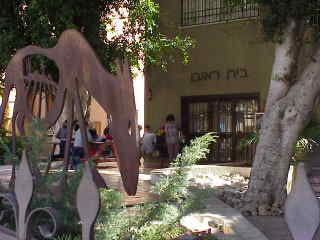
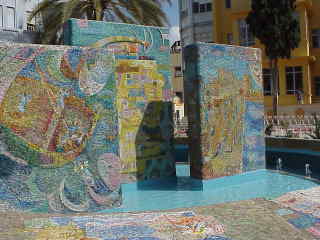 One comment that was almost universal in the emails we received tonight
(we're here at the Netcafe in Jerusalem, after a full day in Tel Aviv,
about which more below), was that we needn't include as much text--that
everyone wants more pictures. So, in the interest of keeping our
immediate costs down, I'm going to include less commentary tonight.
One comment that was almost universal in the emails we received tonight
(we're here at the Netcafe in Jerusalem, after a full day in Tel Aviv,
about which more below), was that we needn't include as much text--that
everyone wants more pictures. So, in the interest of keeping our
immediate costs down, I'm going to include less commentary tonight.
The above picture (to the left) was taken this morning, March 16, of
Reuven Rubin's home; he was a famous Israeli artist, and he lived on
Rehov Bialik. The picture to the right is a mosaic water fountain created
by another Israeli artist, Nahum Gutmann. It depicts the history of Tel
Aviv from ancient times to the rise of the modern city.
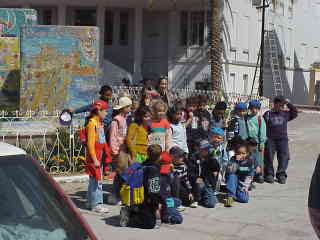
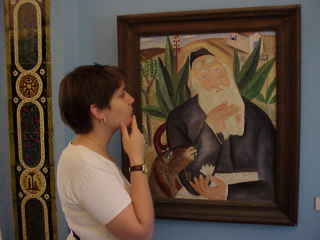 The picture to the left above is of a group of Israeli school kids
getting their photo taken by their teacher in front of the fountain; it
looked too precious not to take! The picture to the right is of me looking at
a picture painted by Reuven Rubin, hanging in Beit Bialik; Chaim Nachman
Bialik was a former national poet considered the father of Hebrew poetry,
and his house was a great place to tour, although all the descriptions of
the photos and paintings were in Hebrew. Oh well.
The picture to the left above is of a group of Israeli school kids
getting their photo taken by their teacher in front of the fountain; it
looked too precious not to take! The picture to the right is of me looking at
a picture painted by Reuven Rubin, hanging in Beit Bialik; Chaim Nachman
Bialik was a former national poet considered the father of Hebrew poetry,
and his house was a great place to tour, although all the descriptions of
the photos and paintings were in Hebrew. Oh well.
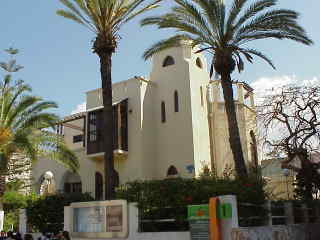
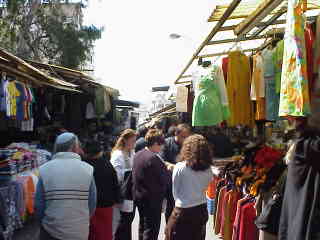 The image above to the left is Beit Bialik from the outside; it was a
large place, considered palatial for the austere pre-Independence days
(according to Fodor's, and we can believe it).
The image above to the left is Beit Bialik from the outside; it was a
large place, considered palatial for the austere pre-Independence days
(according to Fodor's, and we can believe it).
The following text is Adam's impressions of the Carmelite market, the first picture of which is to the right, and the other picture of which, of a huge stand of olives, is below to the left.
Wow, what a cacophony. If Stephen Glass ever writes one of his
postmodern pieces including smells, vendor calls and colors, it will
be based on the Carmel Market. The constant calls of "Shesh shekel!
Shesh shekel! Shesh shekel!" combined with the mixed smells of
strawberries, garlic, spices, fish, polyester clothing and silver
polish was almost too much to bear. Highly amusing nonetheless.
Monica was amazed by the olive selection; neither of us had ever
seen such a variety before, and in such quantity [even in Italy--
go figure. --MNH]. The prices were also unbelievably low; as little
as 2.50 shekels (about 70 cents) for a half kilo of fresh
strawberries.
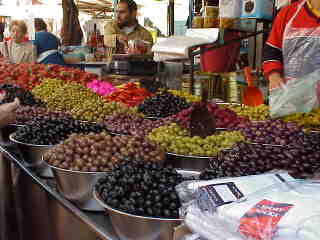
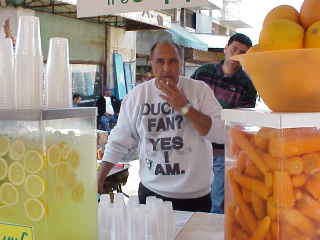 OK, it's Monica writing again. The picture to the right is for Bill
Neal and all the other Mighty Ducks fans in Orange County, Ca., and
elsewhere.
OK, it's Monica writing again. The picture to the right is for Bill
Neal and all the other Mighty Ducks fans in Orange County, Ca., and
elsewhere.
The guy wearing the shirt was a fresh-squeezed-carrot-juice vendor in the Carmelite Market, and when we saw him in his Mighty Ducks shirt, I tried to make a joke about it, but he looked at me as if I were daffy (pun intended). It turned out that not only did he have no idea who the Ducks were; he couldn't even speak English.
We bought the carrot juice anyway.
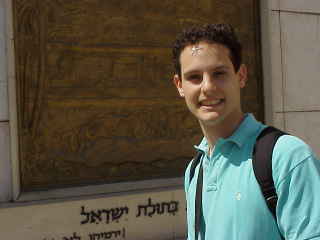
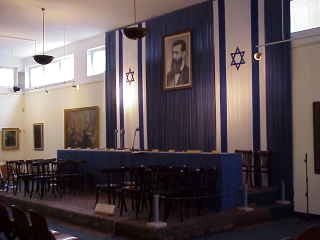 It's Adam, back and usurping Monica's place since she is downstairs
interviewing the guys at the NetCafe. The pic on the left is the
memorial outside the Independence Hall, to which we wandered after
elbowing our way out of the Carmel Market. And, not surprisingly,
to the right is Independence Hall itself. A lot of pro-Israel
puffery, but some interesting notes as well. Apparently, for
instance, the revolutionary committee was considering the name
"Western Palestine" as the name for the new country. Additionally,
the committee decided to call the country "Yisrael" in Hebrew "so
as to make it easier for any Arab nations" that might arise, since
that is how they pronounced it already. Okay, here's your main
tour guide, Monica, again.
It's Adam, back and usurping Monica's place since she is downstairs
interviewing the guys at the NetCafe. The pic on the left is the
memorial outside the Independence Hall, to which we wandered after
elbowing our way out of the Carmel Market. And, not surprisingly,
to the right is Independence Hall itself. A lot of pro-Israel
puffery, but some interesting notes as well. Apparently, for
instance, the revolutionary committee was considering the name
"Western Palestine" as the name for the new country. Additionally,
the committee decided to call the country "Yisrael" in Hebrew "so
as to make it easier for any Arab nations" that might arise, since
that is how they pronounced it already. Okay, here's your main
tour guide, Monica, again.

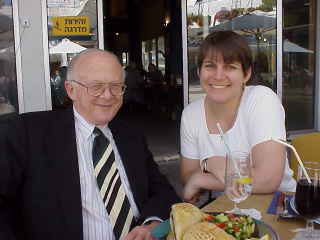 The pictures above/to the left, and to the right, are of Ze'ev Schiff,
a friend and colleague of mine, who's billed at work as the "dean of
Israel's military correspondents."
The pictures above/to the left, and to the right, are of Ze'ev Schiff,
a friend and colleague of mine, who's billed at work as the "dean of
Israel's military correspondents."
Ze'ev is the military editor of Ha'aretz, and he lives near
Tel Aviv. We had lunch with him today in
Ramat Aviv Gimel, and he asked me to tell my coworkers back at The
Washington Institute that he said hi.
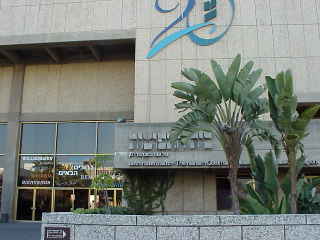
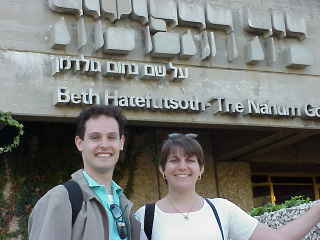
After lunch with Ze'ev, Adam and I hotfooted it over to Beit Hatfutesoth, the Diaspora Museum, at Tel Aviv University (in Ramat Aviv).
The pictures above and below are of the outside of the museum. (The one of the two of us was taken by a fellow tourist, from the Bay Area in California, who was fascinated by the camera; he had never seen one before, but I think he took a pretty good shot. The nice feature is that you can see the image immediately afterward, so even if he hadn't taken a nice shot, we could have lured another unsuspecting tourist into taking a picture of us.)
It would have been nice to photograph the inside, but no photography was allowed.
I will now let Adam add his two cents about this museum, although
unfortunately we didn't get
to spend nearly enough time there (we had to get to Jerusalem to meet
our host at 6 p.m.).
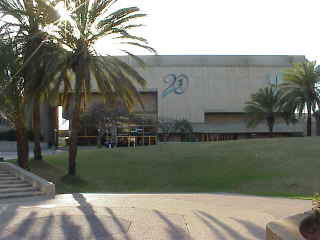

Here's Adam...
As Monica mentioned, quite a rushed tour of the museum, which was a bit unfortunate. I was displeased with the number of beautiful artworks that said, "Replica" or "Facsimile," but I guess many of the originals have been destroyed or lost. By far the greatest highlight of the museum, as Grandma Libbie had suggested, were the models of synagogues from around the world. Some particularly fascinating temples have since been lost, such as the Chinese one. Others interested me because I had seen them (such as the temple in Amsterdam, which I had seen with Mom and Dad Hertzman and Ruth on our trip there. Monica liked the one designed by Frank Lloyd Wright.
Other interesting elements of the museum included photos of Jewish weddings from around the world and songs from various congregations. I also enjoyed the full wall describing the history of Judaism in art, ethics, kaballah, et cetera. At the end of the tour, we met a friendly foursome from California who generously gave us their taxi.
And now that our tale of Tel Aviv is over (until we return, that is), we invite you to click on any of the buttons below to see what we did in the following places, or click here to see what we did on the next day of our trip (in Jerusalem, March 17) ...
Last updated March 16, 1999.